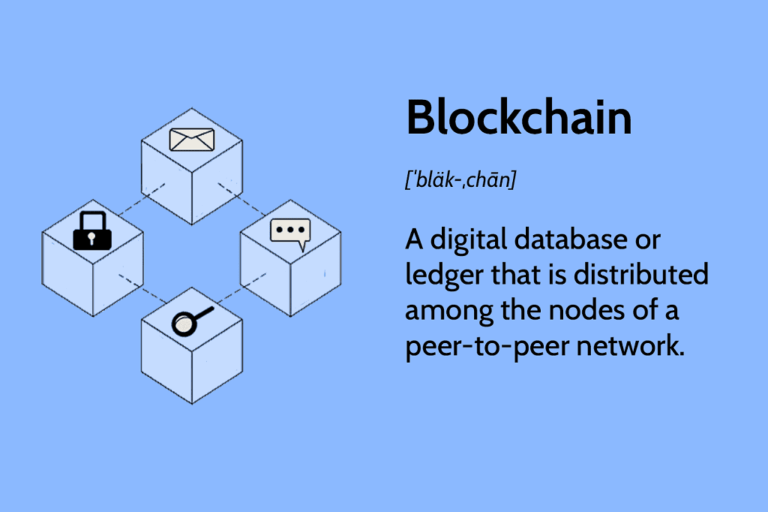
Blockchain, huh? You’ve probably heard this word thrown around a lot lately, but what does it really mean? Well, let’s dive in and explore the world of blockchain together! So, which statement is true about blockchain? Stick around, and we’ll uncover that and more.
Now, before we get into the nitty-gritty, let me break it down for you. Blockchain is like a digital ledger that keeps records of transactions, but here’s the fascinating part – it doesn’t rely on a central authority to manage everything. Nope, it’s a decentralized system that works like magic behind the scenes.
But wait, why is blockchain such a big deal? Well, my friend, it has the potential to revolutionize how we do things. From making secure online payments to tracking supply chains, blockchain can ensure transparency, security, and trust among users. Intrigued? Let’s explore further to find out more about this incredible technology!

Which Statement Is True About Blockchain?
Blockchain technology has garnered significant attention in recent years, with many hailing it as a groundbreaking innovation that has the potential to revolutionize various industries. However, with all the buzz surrounding blockchain, it’s important to separate fact from fiction and understand the true statements about this technology. In this article, we will explore the various aspects of blockchain and debunk common misconceptions to provide you with a clear understanding of what is true about blockchain.
The Immutability of Blockchain
One of the most commonly stated aspects about blockchain is its immutability, which refers to the inability to alter or modify data once it has been recorded on the blockchain. This characteristic is one of the key elements that make blockchain technology secure and trustworthy. When a transaction or piece of information is added to a blockchain, it becomes part of a chain of blocks that are linked together using cryptographic hash functions. Any attempt to modify a block would require altering the subsequent blocks, making it practically impossible to tamper with the data without detection.
However, it’s important to note that while blockchain is highly resistant to tampering, it is not entirely immutable. In rare cases, if a majority of the network participants agree, it is possible to introduce changes to the blockchain through a process known as a “hard fork”. This scenario occurred in 2016 when the Ethereum blockchain underwent a hard fork after the infamous DAO hack, which resulted in the formation of two separate blockchains.
In conclusion, the statement that blockchain is immutable is true in most cases, but it should be understood that there are exceptions under specific circumstances.
The Decentralization of Blockchain
Another commonly stated fact about blockchain is its decentralized nature. Unlike traditional centralized systems where a single entity or authority has control over the data or processes, blockchain is designed to operate in a decentralized manner. In a blockchain network, multiple participants (nodes) maintain a copy of the entire blockchain and validate new transactions through consensus mechanisms such as Proof of Work (PoW) or Proof of Stake (PoS).
This decentralization provides several advantages, such as increased security, transparency, and resilience. Due to the absence of a single point of failure, blockchain networks are highly resistant to attacks and disruptions. Furthermore, the transparent and auditable nature of blockchain allows for increased trust and accountability.
However, it’s important to note that not all blockchains are fully decentralized. Some private or permissioned blockchains may have varying degrees of centralization, where a designated authority or group of entities maintain control over the network. While these blockchains may still provide certain benefits, they do not exhibit the same level of decentralization as public blockchains like Bitcoin or Ethereum.
The Scalability Challenge of Blockchain
One of the main challenges that blockchain technology faces is scalability. Blockchain networks like Bitcoin and Ethereum have been criticized for their limited transaction processing capabilities. These networks rely on a consensus mechanism that requires all participating nodes to reach agreement on the validity of transactions, which can result in slower transaction times and higher fees.
However, various approaches and solutions are being developed to address the scalability challenge of blockchain. Layer 2 solutions such as the Lightning Network for Bitcoin and the upcoming Ethereum 2.0 upgrade aim to enable faster and more scalable transactions on their respective blockchains. Additionally, other projects are exploring alternative consensus mechanisms and sharding techniques to enhance scalability without compromising security or decentralization.
It’s important to recognize that while blockchain technology may currently face scalability limitations, ongoing research and development efforts are working towards improving its performance and scalability in the future.
Benefits of Blockchain Technology
Enhanced Security and Transparency
One of the key benefits of blockchain technology is its enhanced security and transparency. Every transaction added to the blockchain is stored across multiple nodes, making it extremely difficult for hackers or malicious actors to tamper with the data. The transparent nature of blockchain also allows for increased visibility and accountability, as all participants can view and audit the transaction history.
Furthermore, blockchain technology utilizes advanced encryption and cryptographic techniques, ensuring that data remains secure and protected from unauthorized access. This increased security and transparency can be particularly valuable in industries such as finance, supply chain management, and healthcare, where the accuracy and integrity of data are of utmost importance.
Efficiency and Cost Savings
Blockchain has the potential to improve efficiency and reduce costs in various processes and industries. By eliminating the need for intermediaries or trusted third parties, blockchain can streamline operations and facilitate direct peer-to-peer transactions. This can lead to faster transaction times and lower transaction costs, as there are no middlemen involved in the process.
Additionally, blockchain technology enables the automation of complex processes through the use of smart contracts. Smart contracts are self-executing contracts with the terms of the agreement directly written into code. They automatically execute predefined actions when certain conditions are met, eliminating the need for manual intervention and reducing the potential for human errors.
Increased Trust and Traceability
Blockchain technology provides increased trust and traceability by creating a permanent and auditable record of transactions. Each transaction recorded on the blockchain is linked to previous transactions, forming an unchangeable chain of information. This immutable audit trail makes it easy to track and verify the origin, ownership, and movement of assets.
In industries such as supply chain management or provenance verification, blockchain can enable greater visibility and transparency by allowing consumers to trace the journey of products from their origin to the point of sale. This can help combat counterfeit products and unethical practices while providing consumers with confidence in the authenticity and quality of the products they purchase.
Blockchain and Data Privacy
Data privacy is a topic of increasing concern in today’s digital age. As more personal and sensitive data is being collected and stored, protecting that data from unauthorized access and misuse has become paramount. Blockchain technology offers several mechanisms to enhance data privacy and control.
Decentralized Identity Management
One area where blockchain can be utilized to enhance data privacy is in identity management. Traditional identity systems often rely on centralized databases or authorities to store and manage personal information. This centralized approach can be vulnerable to security breaches and exposes users’ data to single points of failure.
Blockchain offers the possibility of decentralized identity management, where individuals have control over their own personal information. By utilizing self-sovereign identity solutions built on blockchain, individuals can store their identity data on a private blockchain and selectively disclose relevant information to service providers without revealing unnecessary personal details.
Private and Permissioned Blockchains
While public blockchains like Bitcoin and Ethereum are open and transparent, there is also the option of private and permissioned blockchains that offer greater control over data privacy. Private blockchains restrict access to a select group of participants who are granted permission to join the network. This allows for more control over data access and ensures that sensitive information is not publicly available.
Private blockchains are particularly well-suited for enterprise use cases where confidentiality and data privacy are of utmost importance. They enable organizations to leverage the benefits of blockchain technology while maintaining strict control over their data.
Enhanced Data Security through Encryption
Blockchain can also enhance data privacy and security through the use of encryption techniques. By encrypting data before storing it on the blockchain, sensitive information can be protected from unauthorized access. Encrypted data is only accessible to those with the appropriate decryption keys, ensuring that unauthorized users cannot view or manipulate the data.
Additionally, blockchain technology can enable secure data sharing through the use of cryptographic techniques such as zero-knowledge proofs. Zero-knowledge proofs allow for the verification of certain information without revealing the actual data itself. This enables secure and private data sharing between parties without the need to disclose sensitive information.
Blockchain and Environmental Impact
With the growing concerns about climate change and environmental sustainability, it is important to consider the environmental impact of technologies like blockchain. Due to its reliance on computationally intensive processes and energy-consuming consensus mechanisms, blockchain has been criticized for its energy consumption and carbon footprint.
Energy-Efficient Consensus Mechanisms
While it is true that certain consensus mechanisms like Proof of Work (PoW) consume significant amounts of energy, there are alternative consensus mechanisms that are more energy-efficient. For example, Proof of Stake (PoS) consensus relies on validators who hold a stake in the network instead of solving complex mathematical puzzles, resulting in considerably lower energy consumption.
Furthermore, ongoing efforts are being made to develop more energy-efficient blockchain solutions. Research and innovation in areas such as consensus algorithms, transaction validation methods, and sustainability-oriented blockchain protocols aim to reduce the environmental impact of blockchain technology.
Positive Impact through Sustainable Use Cases
While blockchain technology may have some environmental drawbacks, it also has the potential to create positive impacts through sustainable use cases. For example, blockchain can enable the transparent tracking of supply chains, allowing consumers to make informed choices based on the environmental footprint of products. This can encourage companies to adopt more sustainable practices and reduce their carbon emissions.
In addition, blockchain-based energy trading platforms can facilitate the adoption of renewable energy sources by enabling peer-to-peer energy transactions and incentivizing the production and consumption of clean energy. This can contribute to a more sustainable and decentralized energy system, reducing reliance on fossil fuels.
In conclusion, blockchain technology offers several true statements, including its immutability, decentralization, and the ongoing challenge of scalability. Furthermore, it provides numerous benefits such as enhanced security and transparency, efficiency and cost savings, increased trust and traceability, and improved data privacy. While the environmental impact of blockchain is a valid concern, ongoing efforts are being made to develop energy-efficient solutions and leverage its potential for positive environmental impact. Understanding these true statements about blockchain can help individuals and organizations make informed decisions when considering the adoption of this transformative technology.
Key Takeaways: Which Statement Is True About Blockchain?
- Blockchain is a decentralized technology that stores records in a secure and transparent way.
- Blockchain can be used for various purposes, not just for cryptocurrencies like Bitcoin.
- Every transaction recorded on the blockchain is permanent and cannot be altered.
- Blockchain eliminates the need for intermediaries, making transactions faster and more efficient.
- Blockchain technology has the potential to revolutionize industries such as finance, supply chain, and healthcare.
Frequently Asked Questions
Blockchain technology has gained significant attention in recent years. Here are some common questions about blockchain and their answers:
What is blockchain and how does it work?
Blockchain is a decentralized digital ledger that records transactions across multiple computers. It works by storing transaction data in blocks that are linked together in a chronological chain. Each block contains a unique cryptographic hash, the previous block’s hash, and the transaction data. This makes it difficult to tamper with the data, ensuring security and transparency.
When a new transaction occurs, it is verified by network participants called nodes. If approved, the transaction is added to a block and broadcasted to the network. Once a block is added to the chain, it is nearly impossible to alter the data within it, making blockchain reliable for various applications.
Is blockchain only used for cryptocurrencies like Bitcoin?
No, blockchain technology is not limited to cryptocurrencies. While cryptocurrencies were the first notable application of blockchain, the technology has expanded to various industries. Blockchain can be used for supply chain management, healthcare records, voting systems, smart contracts, and more. Its ability to provide transparency, security, and immutability makes it suitable for a wide range of applications beyond finance.
For example, in supply chain management, blockchain can track the movement of goods, verify authenticity, and prevent counterfeiting. In healthcare, blockchain can securely store and share patient records, ensuring privacy and accuracy. The potential uses of blockchain technology extend far beyond cryptocurrencies.
What are the benefits of using blockchain technology?
Blockchain technology offers several benefits, including transparency, security, and efficiency. With blockchain, transactions are recorded on a public ledger, allowing for transparency and accountability. Anyone with access can view the transactions, ensuring trust and reducing the need for intermediaries.
Blockchain also enhances security by using cryptography to secure data. Each transaction is linked to the previous one and encrypted, making it extremely hard to alter or manipulate the data. This makes blockchain resistant to fraud or hacking attempts.
Additionally, blockchain streamlines processes and eliminates the need for traditional intermediaries, reducing costs and time. Smart contracts, which are self-executing contracts with predefined conditions, automate business processes, ensuring efficiency and accuracy.
Are blockchain transactions anonymous?
While blockchain transactions do not directly reveal personal information like names or addresses, they are not entirely anonymous. Transactions are identified by unique wallet addresses, which are pseudonyms. These addresses can still be tracked and analyzed, making it possible to associate transactions with specific individuals or entities.
However, privacy-focused cryptocurrencies and technical measures like mixing services or zero-knowledge proofs can enhance privacy and make transactions more difficult to trace. It is essential to understand that while blockchain provides some level of pseudonymity, additional precautions may be necessary for complete anonymity.
Can blockchain be hacked or tampered with?
Blockchain technology is designed to be highly secure and tamper-resistant. Due to its decentralized nature and cryptographic features, altering data on a blockchain is extremely difficult and almost impossible once a block is added to the chain.
To tamper with a blockchain, an attacker would need to control the majority of the network’s computing power, known as a 51% attack. This is incredibly challenging to achieve, especially in well-established and widely used blockchains like Bitcoin or Ethereum. Additionally, the transparent nature of blockchain allows network participants to detect and prevent any suspicious activity that may compromise the integrity of the system.
While blockchain technology is not entirely invulnerable, it is considered highly secure compared to traditional centralized systems. Regular security updates and best practices are crucial to maintaining the strength and integrity of blockchain networks.
Summary
Blockchain is like a big, secure digital ledger that records transactions. It is decentralized, meaning there is no central authority in control. This makes blockchain transparent and resistant to hacking. It can be used to make secure online transactions, track the ownership of assets, vote in elections, and more. However, blockchain is not without its challenges, such as scalability and energy consumption. Despite these challenges, blockchain has the potential to revolutionize many industries and make our online transactions safer and more efficient.




